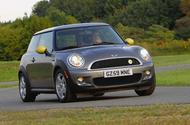Mini’s first trials of a battery-powered model showed promise, and the new car shows how far things have come
It’s nearly a decade since the field trials of the Mini E prototype in the UK. Loaned to selected members of the public (as well as in other countries including the US and Germany), it was an experimental car that lost its rear seats to make way for a battery pack.
Much of BMW’s interest was in tracking real-world use of an EV that had a range limited to around 100 miles in the most favourable conditions.
Different countries showed different habits (US users recharged their Mini Es far more often than users in Germany, for example), but it did prove that even limited-range EVs could be used in the same way as a conventional Mini or BMW 1 Series: most journeys were of no more than 85 miles a day.
New Mini Electric revealed as affordable Brit-built EV
A big problem for the Mini E was the powersapping heating system, which dragged the range down as low as 45 miles in deep winter. I met some of the UK Mini E drivers at the Oxford plant where they cheerily revealed how they wore coats and hats to extend the winter range.
The new electric Mini will be a world away in usability, with four seats and a realworld range that shouldn’t drop below 110 miles even on the coldest day. But will an electric Mini become a mainstream model as part of the fourth-generation Mini? Maybe not.
In June, BMW’s director of development, Klaus Fröhlich, told surprised journalists that there was “no customer requests” for battery-electric vehicles. While “regulators” were demanding them, Fröhlich said the only real markets were in China and California.
He said all other markets would be best accommodated by plug-in hybrids “with a good EV range”. Will such brutal business honesty prevail when BMW is planning the future Mini family?
Source: Autocar
